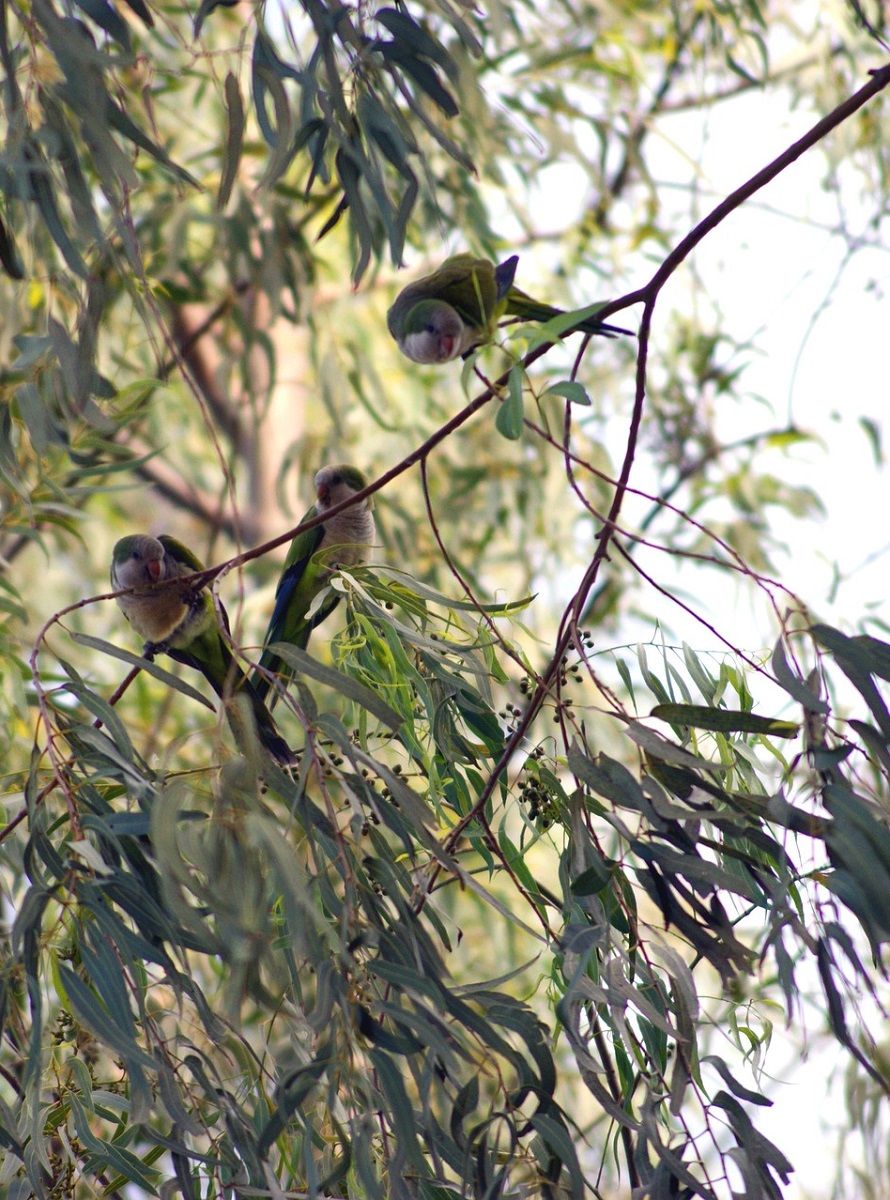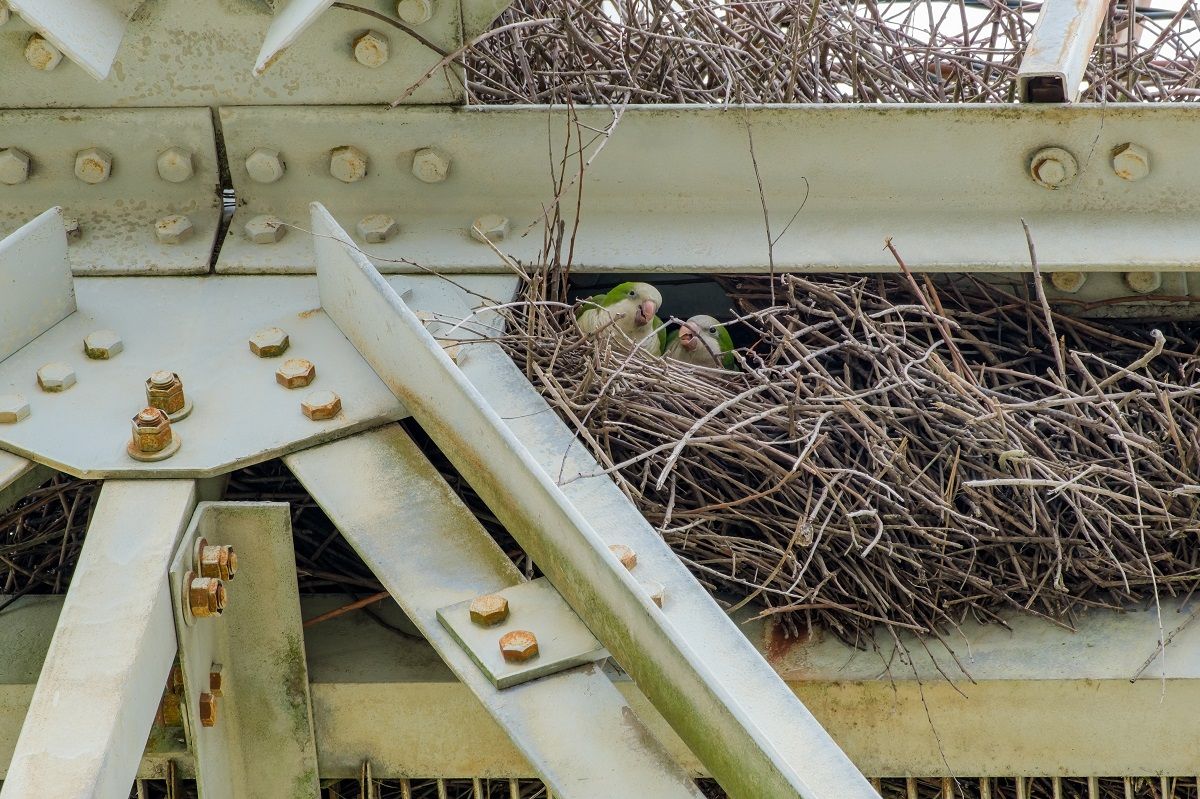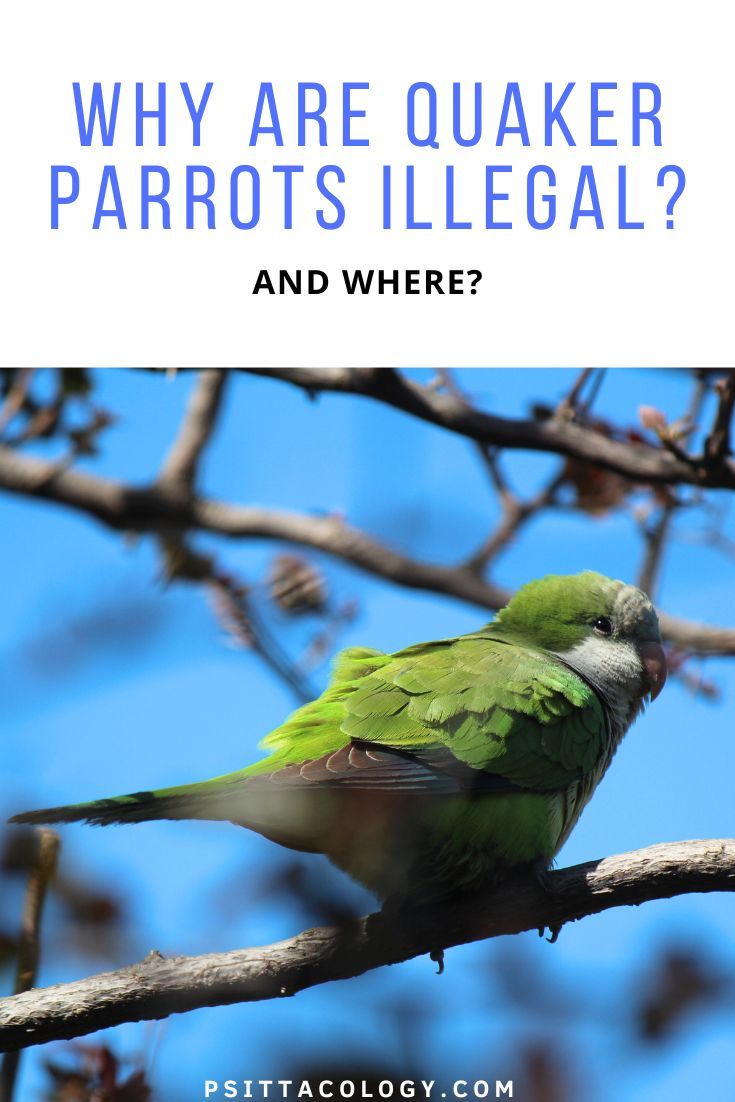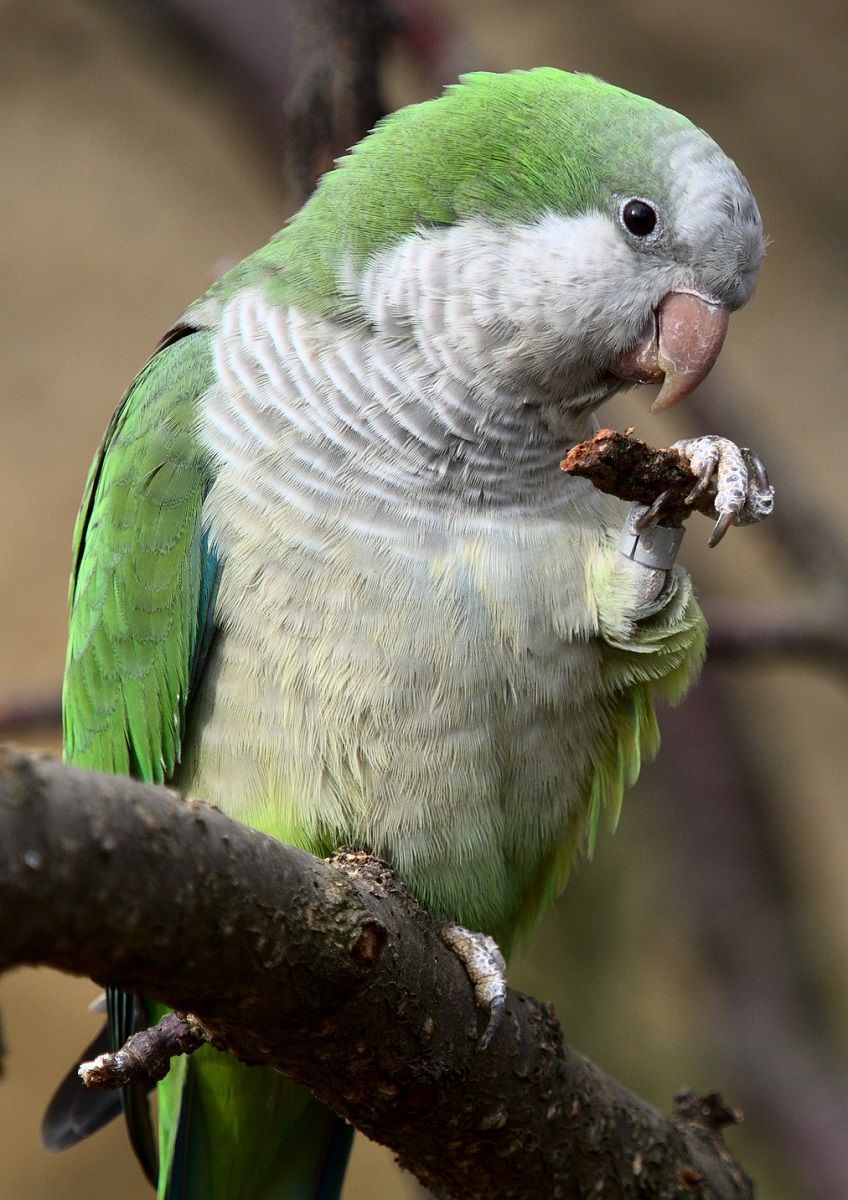If you’re thinking of adding a quaker parrot to your family, it’s important to keep in mind that they’re not legal to own everywhere. Though pretty popular as a pet, this parrot species is banned in many states and countries. But why are quaker parrots illegal? And where are you allowed to keep them?
In this post, let’s have a look at quaker parrot legal status and why some places have decided to ban them as pets.
What is a quaker parrot?
Also known as monk parakeets, quaker parrots (scientific name Myiopsitta monachus) are a small to medium-sized species of South American parrot commonly kept as a pet.
Naturally found in Argentina, Uruguay, Paraguay, Bolivia and parts of Brazil, the quaker parrot can be recognized by its green coloration, with a mousy grey belly and neck and a skin-colored beak.
In the wild, quakers are principally known for the uniquely massive communal nests they build. A quaker parrot nest can weigh up to 1,000 kg (2,200 lbs)! Multiple pairs tend to inhabit the same nest year-round, and they may even share it with different bird species.
As pets, these parrots are appreciated for their smarts, fun personalities and talking abilities. A quaker parrot can be feisty, but with good socialization, these birds can also make fantastic pets and incredibly loyal friends.
If you’d like to keep a quaker, it’s important to keep in mind that they’re not allowed to be kept everywhere. As with some other parrots (notably, the Indian ringneck), sale and ownership can be restricted or even straight-up illegal. Below, let’s have a closer look at why this is the case.
Did you know? These parrots are known for the unique bobbing motion, usually accompanied by wing flapping, which they make when they’re babies. This “quaking” is what earned them their common name! Adult quakers may occasionally quake if they’re annoyed about something.

Why are quaker parrots illegal?
The reason for quaker parrots being illegal in some areas is pretty straightforward: this is a species with huge invasive potential. Feral populations have already established themselves around the world, causing trouble in places as varied as:
- USA: Florida, Texas, New York, Chicago, Washington & more
- Spain: Madrid, Barcelona, Valencia, Canary Islands, Balearic Islands & more
- Rest of Europe: France, Greece, UK, Belgium, Germany, Portugal & more
- South America: Mexico, Brazil, Chile, Puerto Rico & more
- Asia: Japan, South Korea, Singapore
As you might know, quaker parrots aren’t the only parrots that have made it into the wild in places where they don’t belong. Various species have established stable feral populations after escaping or being released from the pet trade and zoos.
It happens easily: a box full of parrots is opened by accident at an airport, or a zoo employee leaves an aviary door open, and voilà… a starter population ready to establish itself is released. If they find a suitable park to live in, they’re golden.
I’ve already mentioned Indian ringneck parrots, which can be found in Great Britain, the US, Spain, Turkey, South Africa and Japan, among other locations. Then there’s the famous feral cherry-headed conure population in San Francisco, Fischer’s lovebirds in Florida and Arizona, and a whole bunch more.
This being said, quakers appear to have been more successful at conquering the world than any of their cousins. What is it that makes them so versatile they can basically be released anywhere and thrive?
One reason is the fact that they’re not from the tropics like many other parrots, meaning they’re adapted to surviving in cooler areas just fine. These hardy birds just need tall structures to build their nests (other parrots require hollow trees), plus plenty of food, which is easy to find in cities and zones where agricultural crops are grown.
Now that we’ve established that monk parakeets are rapidly spreading across the globe, let’s have a look at why that’s a problem – which in turn explains why quaker parrots are illegal in so many places.
Threat to native species
One of the main issues associated with animal and plant species popping up in places they don’t belong is the fact that they compete with native species for resources.
In the case of the quaker parrot, many of the foods they eat (seeds, fruits) are also favored by local species, which can end up going hungry as a result. Additionally, the parrots build their nests in spaces that may otherwise be used by native birds.
Although research has shown that quaker nests are sometimes shared with other species, it’s definitely possible for some birds to struggle as a result of these territorial parrots taking up residence in their habitat.
In addition to this, feral quaker parrots may carry diseases and parasites that can affect local populations.
Agricultural pest
I’ve already briefly mentioned that quaker parrots definitely don’t turn up their noses at agricultural crops. In fact, they love them! Nothing makes a flock of quakers happier than coming across a field full of corn or a fruit tree orchard.
To illustrate: one study in Spain showed that in almost 99% of cases where animals consumed corn (captured on a camera trap), the culprit was a monk parakeet!
Feral quaker parrots munching on farmers’ crops causes millions in damages. It can also lead to community unrest, as farmers tend to favor the culling of the parrots, while other residents may not like this idea.
Did you know? Even in their native range, quaker parrots have long been regarded as pests. It’s thought that increased planting of Eucalyptus trees for the paper pulp industry has led to growth of the population in Argentina, which in turn affects local agriculture.
The nest problem
As we’ve seen, quaker parrots build huge nest constructions. All they need to do it is a tall structure and suitable materials, which they’re not exactly picky about. This means they can construct their nests pretty much anywhere.
In the USA, one of the main problems associated with feral monk parakeet populations is managing nests popping up in utility structures, like poles and electrical stations. Millions of dollars are spent yearly removing nests to prevent short circuits and fire hazards.

Psittacosis
There is some worry that large feral quaker populations can bring with them the risk of psittacosis, a bacterial infection also known as parrot fever, which can affect humans. In very rare cases, psittacosis can be fatal.
Psittacosis isn’t common anymore thanks to regulations on the import and handling of pet parrots. Recently, however, some cases have popped up that were linked to quaker parrots, like an outbreak that required six hospitalizations in Brazil in 2014.
Admittedly, these were pet birds that were acquired illegally and from sketchy sources, but it hasn’t done anything to help quell worries about the possibility of an outbreak.
In addition to psittacosis, quaker parrots can also be vectors for other diseases and parasites. One study in Chile, for example, found that nestlings in the Santiago area were often infected with Cryptosporidium and Giardia, which can infect humans.
Local measures
In some places, like Madrid in Spain, municipalities have begun culling feral quaker parrots in an attempt to stop the population growth. Thousands of birds have already been shot, which has led to considerable controversy.
It seems there are other options. Experiments with DiazaCon™, a contraceptive used to try and stop various feral animal species (grey squirrels, prairie dogs) from spreading further, seem to have proven relatively successful.
Basically, this oral contraceptive is placed in foods that quaker parrots like, which is then left in spots they frequent. The parrots eat it and become infertile, helping to curb population growth.

Where are quaker parrots illegal?
At this point, it should hopefully be clear why quaker parrots are illegal to own in some areas. Local authorities worry that escaped or released birds will cause more and more feral populations to form, leading to all sorts of issues.
If you’d like to own a quaker, it’s very important to check local regulations. Even if they’re illegal, you may be able to find one to buy. But what happens if you’re reported and the bird is taken away to be destroyed, while you get hit with a massive fine?
Here are the states in the US where quaker parrot ownership and trade are restricted or downright banned:
- California
- Connecticut
- Georgia
- Hawaii
- Idaho
- Kansas
- Kentucky
- Maine
- Nebraska (permit needed)
- New Jersey
- Pennsylvania
- Rhode Island
- Tennessee
- Wisconsin
- Wyoming
Quaker parrots are also illegal in much of Europe, as well as Australia and New Zealand, Japan, and other countries. Do your due diligence and check before acquiring one!

Frequently asked questions
A quaker parrot can potentially live to 30+ years, although their lifespan can vary depending on the environment.
Quaker parrots can definitely learn how to talk. As mentioned in the post on quaker parrot talking, though, there’s no guarantee that yours will. You shouldn’t buy a parrot just because you hope it will talk.
If you have any more questions about quaker parrots and their invasive potential as a species, or if you’d like to share your own experiences with these South American parrots, don’t hesitate to leave a comment below!
Sources & further reading
Avery, M. L., Greiner, E. C., Lindsay, J. R., Newman, J. R., & Pruett-Jones, S. (2002). Monk parakeet management at electric utility facilities in south Florida. In Proceedings of the Vertebrate Pest Conference (Vol. 20, No. 20).
Avery, M. L., Yoder, C. A., & Tillman, E. A. (2008). Diazacon inhibits reproduction in invasive monk parakeet populations. The Journal of Wildlife Management, 72(6), 1449-1452.
Castro, J., Sáez, C., & Molina-Morales, M. (2022). The monk parakeet (Myiopsitta monachus) as a potential pest for agriculture in the Mediterranean basin. Biological Invasions, 24(4), 895-903.
Raso, T. F., Ferreira, V. L., Timm, L. N., & De Fátima Tostes Abreu, M. (2014). Psittacosis domiciliary outbreak associated with monk parakeets (Myiopsitta monachus) in Brazil: need for surveillance and control. JMM Case Reports, 1(3), e003343.
Souviron-Priego, L., Muñoz, A. R., Olivero, J., Vargas, J. M., & Fa, J. E. (2018). The legal international wildlife trade favours invasive species establishment: the monk and ring-necked parakeets in Spain. Ardeola, 65(2), 233-246.

I live in New Mexico. I’ve had cockatiels and I love them. When I moved to New Mexico I bought a couple of Quaker parrots. They are everything you read about and more. I don’t cage my parrots and do not clip their wings. Yup, I do a lot of cleanup because of those birds but I don’t regret it for a second. They talk, bark, chirp and scream. Lately they picked up my laugh and are always laughing at me. I’m hoping after a few more months they’ll let me in their flock.
Thanks for sharing! I love quakers as well. They’re illegal to keep where I live, but I can spot feral populations wherever I want here in Spain. Enjoy your birds 🙂